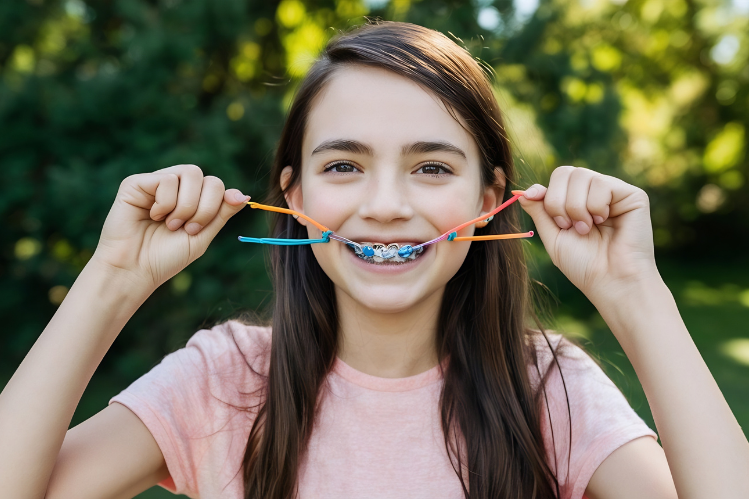
Table of Contents
- What Exactly Are Rubber Bands for Braces?
- Types of Rubber Bands (Because Not All Are the Same)
- The Science Behind It: How Rubber Bands Actually Work
- Rubber Band in Mouth: The Struggle is Temporary
- Color, Style, and Personality: The Fun Part of Teeth Rubber Bands
- Making Braces a Vibe
- The Function Behind the Fun
- When Rubber Bands Aren’t for You
- How to Care for Rubber Bands and Keep Things Clean
- The Power of Patience
- The Final Stretch: What Happens When They Come Off
- A Thought to Leave You With
- FAQs
If you have observed someone talking or smiling while wearing braces and noticed those tiny stretchy loops that linked their teeth together, you may have thought to yourself, "What is going on with that?" Those little guys are what orthodontists call rubber bands. While they may appear to be just for show, rubber on braces does a lot more than you originally imagined.
Although they may just seem like briefly fun accessories, lots of work is actually going on behind the scenes to help create that perfect smile. Rubber bands for braces are seriously the unsung heroes of orthodontics. They look fun, come in a lot of colors, and somehow combine science with style.
Let’s break down what rubber band orthodontics is all about, and why it’s important, all while adding fun to the process.
What Exactly Are Rubber Bands for Braces?

Let’s start with the basics.
When you get braces, you’re not just getting brackets and wires. You’re also getting an entire system that uses pressure and tension to move your teeth into alignment. That’s where rubber bands for braces, also known as elastic rubber bands for teeth, come in.
They’re small loops made of medical-grade latex (or latex-free material if you’re allergic). They attach to tiny hooks on your brackets and help guide your teeth and jaw into their correct positions. Without them, braces would only be doing half the job.
You can think of them as the muscle behind the movement. The wire directs, but the rubber band in braces provides the strength to pull everything together.
Types of Rubber Bands (Because Not All Are the Same)

Orthodontists use different kinds of rubber bands depending on what your smile needs. Here’s a quick breakdown:
| Type | Where It’s Used | Purpose |
|---|---|---|
| Ligature Bands | Around each bracket | Hold the wire in place |
| Interarch Bands | Between the top and bottom teeth | Correct the bite alignment |
Ligatures are the ones you see in color. Interarch ones, those are the ones that stretch when you open your mouth and make you feel like your jaw’s in the gym.
Some people even call it the rubber band mouth phase of braces. It’s the stage where you can’t say certain words without sounding a little funny. But don’t worry, you get used to it fast.
The Science Behind It: How Rubber Bands Actually Work
Alright, here’s the cool part. When your orthodontist gives you a rubber band for braces, they’re setting up a plan that uses physics and biology in perfect harmony. These bands stretch between your upper and lower teeth to fix issues like:
Common Issues Addressed by Rubber Band for Braces:
Overbites
An overbite occurs when the upper front teeth protrude significantly over the lower front teeth. This condition can cause aesthetic concerns and may lead to functional issues during biting and chewing.
- Role of Rubber Bands: Rubber bands can be applied to help retract the upper teeth or bring the lower teeth forward to achieve a more balanced bite.
Underbites
An underbite is characterized by the lower teeth extending beyond the upper teeth, often leading to discomfort and difficulty in chewing and speaking.
- Role of Rubber Bands: In this case, rubber bands are used to push the upper teeth into a more forward position or to pull the lower teeth back, correcting the bite alignment.
Crossbites
A crossbite occurs when some of the upper teeth rest inside the lower teeth when the mouth is closed. This misalignment can lead to uneven wear on teeth and jaw discomfort.
- Role of Rubber Bands: Rubber bands can help correct crossbites by adjusting the position of specific teeth or aligning the jaw to encourage proper occlusion.
Open Bites
An open bite happens when there is a gap between the upper and lower teeth when the mouth is closed. This can result in difficulty biting into foods and can affect speech.
- Role of Rubber Bands: To address open bites, rubber bands can be used to pull down or push up teeth so they align more closely, ultimately closing the gap and enhancing function.
Each type of movement requires a specific pattern or configuration of rubber bands for braces. Some pull diagonally, others vertically. And the tension you feel? That’s exactly what helps your jaw adjust.
It’s pretty fascinating that something as simple as a stretchy band can help reshape your smile. It’s small-scale biomechanics happening right in your mouth.
Rubber Band in Mouth: The Struggle is Temporary
Let’s face it: having a rubber band in the mouth is an adjustment. Talking feels weird at first, and eating? That takes practice. You might even shoot one across the room accidentally (happens to the best of us).
Here’s the truth: teeth rubber bands are a crucial part of your progress. That slight tightness and soreness you feel means the treatment is working.
To make it easier, a few simple tips go a long way:
- Always keep extra rubber on the braces with you. They can snap anytime.
- Replace them exactly as instructed by your orthodontist.
- Avoid doubling them; more pressure doesn’t mean faster results.
- Remove them before eating or brushing.
After a few weeks, your mouth adjusts, and you’ll barely notice them. Until one pings out in class or at dinner, then it’s pure chaos for a second.
Color, Style, and Personality: The Fun Part of Teeth Rubber Bands

Okay, now let’s talk about what makes this whole braces thing a little more bearable, the colors.
You can actually customize your rubber band for braces to match your mood, outfit, or even the season. And yes, some people take this very seriously. Think of it as turning your braces into fashion accessories. From clear rubber bands to jet black ones, there are a lot of options.
Here’s a color guide for inspiration:
| Color | Best For | Aesthetic |
|---|---|---|
| Clear Rubber bands | Minimalists | Subtle but can stain easily |
| Black Rubber bands | Everyone | Makes teeth look whiter |
| Blue Rubber bands | Most skin tones | Safe and cool-toned |
| Red Rubber bands | Statement lovers | Bold and confident |
| Green Rubber bands | Risk-takers | Trendy but tricky, it can look like food |
| Pink Rubber bands | Fun personalities | Bright, cheerful |
| Purple Rubber bands | Creative types | Slightly mysterious |
| Orange/Yellow Rubber bands | Adventurous | Not everyone’s choice, but fun! |
Some orthodontists even offer glow-in-the-dark options. Imagine showing up to a sleepover with glowing teeth. Weirdly awesome.
Changing colors at every appointment can actually make the process more exciting. Think of it like seasonal fashion, your braces, your style.
Making Braces a Vibe
People used to hide their braces. Not anymore. Gen Z turned them into a full-blown aesthetic. There are TikToks rating color combos, threads debating which hue looks best on different skin tones, and even Pinterest boards dedicated to “braces glow-ups.”
Here are a few braces plus rubber bands combo ideas if you’re feeling adventurous:
- Pastel blue + white – clean and fresh
- Purple + teal – artsy and cool
- Red + silver – bold, confident energy
- Black + gold – classy and sharp
Honestly, braces have become a new kind of self-expression. Your rubber band in braces doesn’t have to look clinical; it can match your personality, your vibe, or even your favorite playlist.
The Function Behind the Fun
While you’re out here picking colors, don’t forget the main job of a rubber band for orthodontics: movement. Every elastic is strategically placed for a reason.
Orthodontists might change your rubber bands for braces setup every few weeks as your teeth shift. Sometimes it’s subtle, other times it’s completely different. The new configuration targets a new movement or rotation.
So, yeah, it’s not random. It’s carefully calculated. And your job is just to wear them consistently, no matter how small or weird they feel at first; your progress pauses.
Consistency is everything with a rubber band for orthodontics.
When Rubber Bands Aren’t for You

Let’s be real, not everyone loves the idea of colorful braces or the constant maintenance of rubber on braces. Some people just want something sleek and invisible.
If your case is mild to moderate, and you’d rather skip the brackets altogether, ALIGNERCO clear aligners are the way to go.
Unlike traditional braces with a rubber band, ALIGNERCO aligners straighten your teeth quietly, no wires, no colors, no awkward ping sounds mid-laugh. You can remove them when eating or brushing, and no one can tell you’re even wearing them.
They’re comfortable, affordable, and perfect for anyone who wants a discreet journey to a confident smile, especially if you’re in Canada and looking for an at-home option.
How to Care for Rubber Bands and Keep Things Clean
This part’s not glamorous, but it’s crucial. Rubber bands for braces can trap food or plaque, and skipping cleaning can lead to staining or decay.
Here’s your quick guide on how you can avoid staining the rubber bands :
- Brush at least twice daily.
- Use interdental brushes around brackets.
- Floss, yes, it’s a pain, but necessary.
- Replace your teeth rubber band daily (or more often if told).
- Keep a small mirror and travel toothbrush in your bag.
And seriously, avoid sticky stuff like caramel, gum, or hard candies. They’re a disaster waiting to happen.
The Power of Patience
The thing about rubber bands for orthodontics is that they test your patience. It’s slow progress. Some days you’ll wonder if anything’s moving at all. But give it time.
One day, you’ll catch a glimpse of your reflection and realize your bite looks different. Your smile feels stronger. The months of elastic snapping and awkward lisping will start to feel worth it.
Braces aren’t forever. But the results? They stick with you for life.
The Final Stretch: What Happens When They Come Off
When your orthodontist finally says it’s time to remove your rubber band for braces, it’s like finishing a marathon. You’ll feel lighter, your bite will feel even, and your smile will look amazing. You’ll probably get a retainer afterward (sorry, not optional). It helps keep your teeth from shifting back. But compared to rubber band mouth, retainers are a breeze.
That first smile without braces, pure magic. All those months of changing colors, switching elastics, and surviving popcorn bans suddenly make sense.
A Thought to Leave You With
Whether you're wearing neon rubber on braces or using clear aligners, here’s the deal: every adjustment, every band replacement or stretch, every moment of discomfort is another moment your smile is changing.
It’s easy to get caught up in the little annoyances, the pinging, the tightness, the occasional rubber band snap in front of a stranger. But, your future self? They are going to be thanking you for sticking with it.
Braces are not just about getting straight teeth. They are about patience and confidence, and sometimes even humor. So, go ahead, pick your color, fix your bands, and take pride in your journey. Because that glow-up you are looking forward to? It’s in process.
FAQs
1. How do rubber bands on braces work?
They apply gentle pressure to help move your teeth and jaw into the right alignment, improving how your bite fits together.
2. What do the different positions of elastics mean for braces?
Each position targets a specific correction, like fixing overbites, underbites, or shifting teeth into better alignment.
3. Are rubber bands the last stage of braces?
Usually, yes. They’re often used toward the end of treatment to fine-tune your bite and finish alignment details.
4. How long does it take for elastics to move teeth?
You can start noticing changes within a few weeks, but full movement usually takes several months of consistent wear.
5. What are the stages of braces?
Generally, alignment, bite correction, finishing touches, and then retention with a retainer.
6. What happens if I don't wear my rubber bands for 2 days?
Your teeth can shift back slightly, slowing your progress. It’s best to wear them exactly as your orthodontist advises.
7. How many hours a day should bands be worn?
Most orthodontists recommend 20–22 hours a day, basically, all the time except when eating or brushing.
Citations:
Professional, C. C. M. (2025e, August 18). Teeth Braces. Cleveland Clinic. https://my.clevelandclinic.org/health/treatments/24601-teeth-braces
Rubber Bands for Braces | Indigo Orthodontics. (n.d.). Orthodontist Columbia SC Invisalign Braces | Indigo Orthodontics. https://indigoorthodontist.com/elastics-for-braces-explained/






